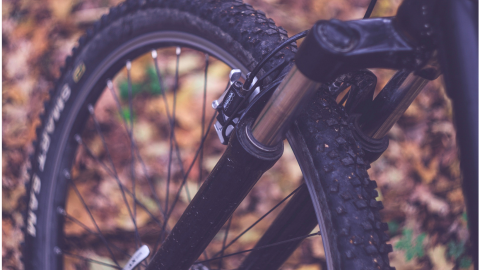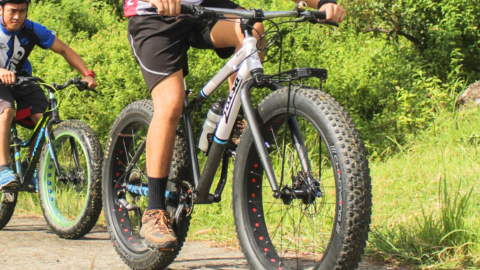Mountain bikes use suspension systems to absorb bumps and rough terrain. A typical system consists of a spring inside a tube attached to the frame. When the rider hits a bump, the spring stretches and compresses, which absorbs some of the force of the impact. This allows the rider to continue riding safely without getting injured.
In this article, we will show you how the shock works and some other information regarding that. So, Read on.
What do Shocks do on a Mountain Bike?

In order to improve the performance of a shock, you need to understand how the shock works. There are two basic categories of shocks: air-sprung and coil-spring. Air springs are the original form of shock, and they rely on compressed air to operate. Coil-spring shocks use a spring to store energy and release it gradually during compression.
Both types of shocks are available in both open and closed designs. Open designs let air pass through the system, while closed systems prevent air from passing through. Closed shocks tend to last longer than open ones, but open designs offer greater adjustability.
Some shocks feature damping technology, which controls how much force the shock applies to the wheel. Damping increases the amount of feedback a rider feels from bumps, giving the rider a smoother ride.
Why Do We Need Shocks in Mountain Bikes?
Mountain bikes aren’t designed for racing, but many riders still compete in races like downhill, cross country, and enduro. These events require a lot of power, speed, and control. To achieve these feats, racers need top-notch components like shocks.
A good shock provides smooth, responsive suspension, allowing racers to maintain optimal traction on rough terrain. The best shocks also keep the rider upright, preventing him or her from falling off the bicycle. While race bikes may look different from normal bikes, shocks perform exactly the same functions.
How Shock works on a mountain Bike
The rear shock is composed of a spring (coil or air) and a damper, just like a fork. Don’t forget that the spring is what actually causes your shock to compress and decompress, and the damper regulates how rapidly that happens (rebound).
The main distinction is that your fork’s spring components are housed in one stanchion, and the damping components are housed in the other. The rear shock’s damper is often encased by the spring due to the lack of available space.
Shock Absorbers Components
The damper body of your shock (also called a stanchion) has two functions. To begin, the seal for your air spring is the outer surface of the damper body. Therefore, keeping this region clean and scratch-free is crucial. Second, it’s where you keep the fluid that regulates the damping and rebound of your vehicle’s suspension. Here’s a rundown of what’s happening within the damper body of your shock.
The seal head is attached through threads to the damper body, which houses the damping system and any fluid it uses. Damper fluid flows past the piston as the shock is compressed and released. By adjusting the amount of fluid flow via the piston, the damping properties can be altered.
Aerospace Components
Two-chamber air canisters come in a wide variety of sizes and shapes, allowing the spring rate of the shock to be adjusted accordingly. To create the upper seal, the air can be screwed directly into the shock’s head (the section containing the valve stem and controls).
When using a shock pump to pressurize an air canister, the air is forced into what is called the positive chamber. An effective counterbalance to the rider’s mass is provided by force generated in the positive chamber. The spring is created by the compression of air in the positive chamber as the seal head slides up the piston shaft during rear wheel travel.
Air Springs vs. Coil Springs
Coil-spring shocks are generally lighter, quieter, and more durable than air-sprung models. They’re also cheaper to produce and repair, but they don’t compress as far as air-sprung shocks. Air-sprung shocks are typically heavier and louder, but they’re also more adjustable since they don’t restrict airflow.
Compression Speed: Low vs. High Speed
When we say “low speed,” we’re referring to the compression speed of the suspension shaft. What we mean by “low-speed compression damping” refers to how the suspension of a mountain bike responds to slow compression forces, such as those generated by pedaling, the rider’s weight, cornering, braking, etc.
Expectedly, this is how the suspension of a mountain bike responds to increased rotational speed in the drivetrain. Shaft speed is high in situations like landings, square-edged bumps, and trail input at high speeds. In other instances, this will only take effect at the very end of your suspension’s travel.
This is another option that is typically only included on more expensive devices and comes preset or uninstalled altogether.
Choosing Your Shock

There are three things to consider when choosing a shock: stroke length, travel range, and rebound adjustment. Stroke length refers to the distance traveled by the piston before compressing the air chamber. Travel range is measured in millimeters (mm). Rebound is the maximum height a shock reaches after releasing the spring.
Short strokes and low travel ranges give a stiff feel, while longer strokes and high travel ranges result in softer rides. Riders often prefer shorter strokes and lower travel ranges, especially when riding over rougher surfaces. Higher rebound settings are great for technical trails, where riders want to control the amount of bounce on steep climbs and descents. High rebounds are also ideal for racing since they enable racers to hold their line without bouncing excessively.
Adjusting Your Suspension
If you’ve ever ridden a mountain bike, you already know that adjusting your suspension isn’t easy. Most suspensions are controlled using levers or knobs, but newer models feature digital displays to make adjustments easier. Adjustments include preload, rebound, lockout, and compression. Preloading adjusts the initial pressure applied to the shock body.
It affects the overall stiffness of the suspension, but it doesn’t affect rebound or compression. Rebound determines how high the shock bounces after bottoming out. Lockout prevents the shock from moving past its lowest point. Compression sets the degree of compression achieved by the shock. Each set has a corresponding knob or lever, so you can easily see what each adjustment does.
Conclusion
In conclusion, mountain bikes use a suspension system called a shock absorber. This works by using air pressure to compress the spring inside the shock, which allows it to absorb bumps and vibrations from the road. When the rider hits a bump, the force causes the air inside the shock to expand, causing the spring to release its energy. This gives the rider a smooth ride without having to worry about jarring his or her bones after hitting a pothole or curb. We hope you’ve found this article useful enough.

I am Ryan Ford, a mountain biking enthusiast who loves to explore the outdoors. I also like to go on adventures with friends and anything else that involves being outside. I love my bike because it gets me out of the house and gives me an opportunity to enjoy nature.


